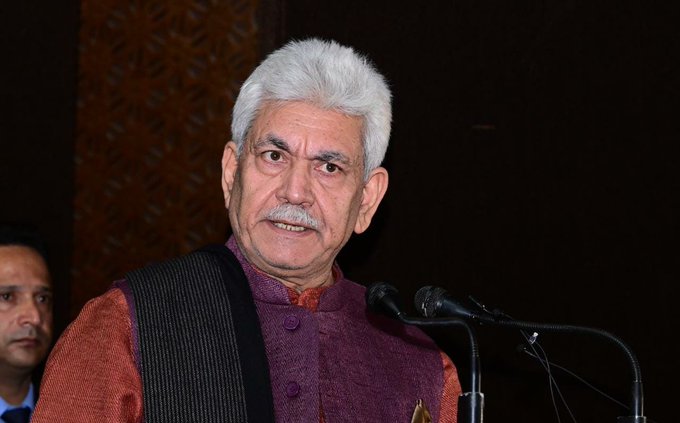

Manoj Sinha, Lt. Governor of Jammu and Kashmir
The Indian Army landed in Srinagar for the first time on 27 October 1947, 5 days after the Pakistani raiders started their invasion from Muzaffarabad and a day after Maharaja Hari Singh signed the Instrument of Accession of the State of Jammu and Kashmir. It is celebrated as Infantry Day in India.
Pakistan observes 27 October as a ‘Black Day’. However, there is no historical evidence of this day having been observed as ‘black’ in the Kashmir valley from 1947 to 1989. In August-September 1989, the shadows of terrorism had begun to spread over the valley. Mohammad Yousuf Halwai of the National Conference (NC) was the first civilian who was gunned down on 16 August 1989 for refusing to put off the lights of his house on the Indian Independence Day.
The Jammu and Kashmir Liberation Front (JKLF) had called for a “total blackout” in Kashmir on 15 August, the Indian Independence Day. On 14 August, the Pakistan Independence Day, JKLF’s guerrillas carried out a brief parade at Gani Memorial Stadium in downtown Srinagar. Halwai’s assassination in broad daylight spread a wave of terror across Srinagar.
A month later, on 14 September 1989, senior Jan Singh and BJP leader Tika Lal Taploo was shot dead near his home in the Pandit-dominated Habbakadal neighbourhood. Neelkant Ganjoo, the retired judge who had awarded death sentence to the JKLF founder Maqbool Bhat for a murder, was shot dead at Hari Singh High Street, yards away from the Jammu and Kashmir High Court, on 4 November 1989. In between came 27 October—the first shutdown on the Infantry Day in Kashmir.
The real turning point came with the release of the five JKLF militants in exchange for Rubaiya Sayeed, the daughter of the then Union Home Minister Mufti Mohammad Sayeed who had been kidnapped in a week of his assuming office. There were nightlong celebrations across Srinagar and the rest of the valley, making the militants ‘heroes’ and all those identifying themselves with India ‘villains’ and ‘traitors’.
Farooq Abdullah’s government collapsed when he resigned on 18 January 1990 to protest Jagmohan’s appointment as the Governor of Jammu and Kashmir. Rest is the history—every next day a hartal or curfew, almost every day one or multiple killings. The separatists and the militants called for shutdown for anything, and enforced the same often at gun point.
For many years, not an individual, not a vehicle would dare to move out on the Indian Independence Day, the Indian Republic Day and the Infantry Day.
There was a thaw after the insurgency was crushed forcefully in Farooq Abdullah’s next regime from 1996 to 2002. So there was not much impact out of the militants’ and the separatists’ calls for hartal till July 2008 when Mufti Mohammad Sayeed brought down his coalition partner Ghulam Nabi Azad’s government over the allotment of a piece of land to Shri Amarnath Shrine Board.
The political vacuum was swiftly filled up by the separatists. Hardliner Syed Ali Shah Geelani retained the key to Kashmir’s peace and turbulence for over a decade. His unceasing hartal calendars crippled Kashmir all through the street turmoil of 2008, 2009, 2010 and finally 2016. His influence began to shrink only after the BJP-led Centre removed Mehbooba Mufti as the Chief Minister. Still, there was considerable impact of his calls even after 2018.
On 27 October 2017, there was total shutdown on the call of ‘Joint Resistance Leadership’ (JRL) comprising Geelani, Mirwaiz Umar Farooq and Yasin Malik. Not a shop was open. Few vehicles ventured out.
After the State’s reorganisation and withdrawal of the special status, by way of abrogation of Article 370 and 35-A on 5 August 2019, there was a prolonged period of curfew and shutdown.
When the situation eased in March 2020 and the educational institutions began to open, the Covid pandemic struck the valley like the rest of the world. By August and October 2021, there was a marked change in the situation. All the separatist demonstrations, attacks on security forces and Police, stone pelting and funeral processions and gun salutes for the slain militants disappeared dramatically. Still some shops were closed and businesses remained shuttered on certain days.
As a large number of the militants were killed in hundreds of encounters, most of the separatist leaders were either detained in jails or held under house arrest and the unbridled social media was for the first time contained, normalcy began to spread to the length and breadth of the valley. Meanwhile five prominent separatist leaders—including Syed Ali Shah Geelani, Mohammad Ashraf Sehrai and Maulvi Abbas Ansari—died in a short span of 18 months from May 2021 to October 2022.
Also Read: Deaths, defections, and the collapse of the Hurriyat conference in Kashmir
And when the 75th anniversary of the Indian Army’s first arrival in Kashmir came on 27 October 2022, there was neither a call nor a hartal. All the businesses, government and private offices, banks, schools, colleges and universities functioned normally. All modes of private and commercial traffic operated without any hassles.
There was nobody on the road to question defiance to the hartal call, nobody to check the photo-identity cards in the passenger buses and nobody to strip and humiliate the poor policemen and nobody to verify the abdominal surgeries of the female patients unlike the scene in 2016-18.
The Defence Research and Development Organisation has offered 28 of its designed and developed weapon…
Nepal Foreign Minister Arzu Rana Deuba announced that 11 Nepali nationals being evacuated from Iran…
On June 21, 2025 (BST), Sikyong Penpa Tsering from the Central Tibetan Administration received a…
Strengthening maritime cooperation in the Indian Ocean Region, INS Teg, a frontline stealth frigate of…
Union Minister Hardeep Singh Puri paid tributes to the victims of the Kanishka bombing and…
The Baloch Yakjehti Committee marked three months since the arrest of the organisation's leaders such…